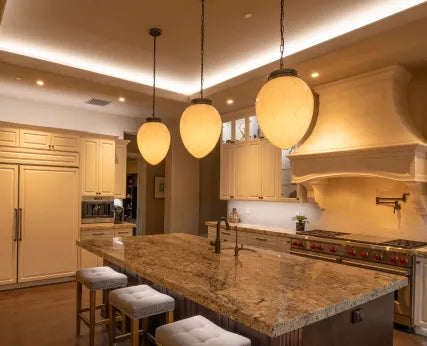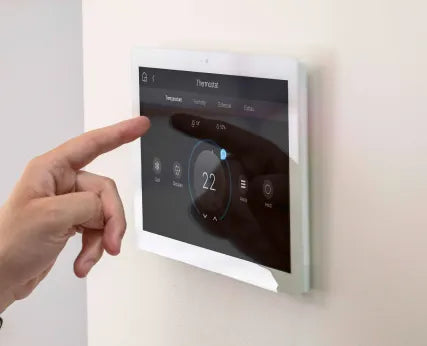Home security has evolved far beyond traditional deadbolts and key chains. Smart locks represent the next generation of door security, offering keyless entry, remote access, and advanced monitoring features that transform how we protect our homes.
These innovative devices eliminate the frustration of lost keys while providing unprecedented control over who enters your home and when. From busy families juggling multiple schedules to homeowners seeking enhanced security, smart locks deliver convenience and peace of mind in one sleek package.
This comprehensive guide will walk you through everything you need to know about selecting the perfect smart lock for your specific needs, door type, and budget. By the end, you'll have the knowledge to make an informed decision that enhances both your home's security and your daily routine.
Understanding Best Smart Lock Technology
Smart locks operate through various technologies, each offering distinct advantages depending on your preferences and home setup. The most common connection methods include Wi-Fi, Bluetooth, Z-Wave, and Zigbee protocols.
Wi-Fi enabled smart locks connect directly to your home network, allowing remote access from anywhere with internet connectivity. These locks typically offer the most features but may consume more battery power than other options.
Bluetooth smart locks provide secure, short-range connectivity that works well for proximity-based unlocking. When you approach your door with your smartphone, the lock automatically detects your presence and can unlock without requiring internet access.
Z-Wave and Zigbee locks integrate seamlessly with existing smart home ecosystems, creating a mesh network that extends throughout your property. These protocols often provide more reliable connectivity and better battery life compared to Wi-Fi alternatives.
Apple Home Key Features to Consider
When evaluating smart locks, several essential features should guide your decision-making process. Understanding these capabilities helps ensure your chosen lock meets both current needs and future requirements.
Entry Methods
Modern smart locks offer multiple ways to unlock your door. Smartphone apps provide the most common access method, allowing you to unlock remotely or grant temporary access to guests. Many models also include backup options like keypads for code entry, physical keys for emergencies, or biometric scanners for fingerprint recognition.
Consider which entry methods align with your household's preferences. Families with children might prefer keypad entry to avoid lost phones, while tech-savvy users may gravitate toward app-based controls and voice activation compatibility.
Battery Life and Power Options
Most smart locks run on batteries, making power management a crucial consideration. Premium models typically last 6-12 months on a single set of batteries, while basic versions may require more frequent replacements.
Look for locks with low-battery warnings that alert you through smartphone notifications before power runs out. Some advanced models include backup power options, such as external battery packs or micro-USB charging ports for emergency situations.
Integration Capabilities
Smart locks truly shine when integrated with broader home automation systems. Compatibility with platforms like Amazon Alexa, Google Assistant, Apple HomeKit, or Samsung SmartThings enables voice control and automated routines.
Consider how your smart lock will interact with other devices. Popular integrations include automatic unlocking when security systems disarm, lights turning on when doors unlock, or cameras recording when specific users enter.
Installation Requirements and Compatibility
Before purchasing any smart lock, carefully assess your current door setup and installation requirements. Most smart locks replace existing deadbolts, but compatibility varies significantly between models and door types.
Door Thickness and Hardware
Standard smart locks accommodate doors between 1⅜ and 2¼ inches thick. Measure your door thickness precisely, as some premium models work with thicker doors while budget options may have more restrictive requirements.
Check your existing deadbolt hole size and backset distance (the measurement from the door edge to the center of the deadbolt hole). Standard backsets measure 2⅜ or 2¾ inches, and most smart locks accommodate both measurements with adjustable components.
Installation Complexity
Smart lock installation ranges from simple DIY projects to complex professional installations. Basic models that replace standard deadbolts typically require only a screwdriver and 30-60 minutes of time.
More advanced locks with additional sensors, cameras, or custom door modifications may require professional installation. Factor these potential costs into your budget when comparing options.
Consider your comfort level with technology and basic home improvement tasks. While most manufacturers provide detailed installation guides and video tutorials, some users prefer professional installation for peace of mind.
Security Considerations
Smart locks introduce new security vectors that traditional locks don't face. Understanding these considerations helps you choose models with robust protection against both digital and physical attacks.
Encryption and Security Protocols
Look for smart locks that use advanced encryption standards (AES 128-bit or higher) to protect communication between your lock and connected devices. Reputable manufacturers regularly release firmware updates to address newly discovered vulnerabilities.
Two-factor authentication adds an extra security layer for app access, while tamper alerts notify you of physical manipulation attempts. Some premium models include built-in alarms that sound when someone tries to force entry.
Backup Access Methods
Digital failures happen, making backup access methods essential. Physical key overrides ensure you're never locked out during power outages, network failures, or smartphone malfunctions.
Consider mechanical backup options carefully. Some locks hide physical keyways behind removable covers, while others integrate traditional keyholes seamlessly into their designs. Choose based on your aesthetic preferences and security comfort level.
Popular Smart Door Lock Types
The smart lock market offers several distinct categories, each designed for specific use cases and installation scenarios.
Retrofit Smart Locks
Retrofit models attach to your existing deadbolt's interior thumb turn, preserving your current lock's exterior appearance while adding smart functionality. These options work well for renters or those wanting minimal exterior changes.
Installation typically requires no drilling or exterior modifications, making retrofit locks ideal for apartments or homes with architectural restrictions. However, they may offer fewer features than full-replacement alternatives.
Full Replacement Smart Locks
Complete replacement smart locks substitute your entire existing deadbolt with new smart hardware. These models typically offer more features, better integration, and sleeker aesthetics compared to retrofit options.
Full replacements provide the most comprehensive smart lock experience but require complete deadbolt removal and installation. Consider this option if you own your home and want maximum functionality.
Smart Lock Handles
Lever-style smart locks combine door handles with smart locking mechanisms, common in commercial settings but increasingly popular for residential use. These locks work particularly well on interior doors or specific exterior applications.
Handle-style smart locks often include additional features like automatic locking when doors close, making them convenient for high-traffic areas or families with young children.
Budget Considerations and Value
Smart lock prices vary dramatically, from basic models under $100 to premium options exceeding $500. Understanding what features justify higher costs helps you find the best value for your specific needs.
Entry-Level Options
Budget smart locks typically offer basic smartphone app connectivity, keypad entry, and standard battery life. While feature sets may be limited, these models provide essential smart lock benefits at accessible price points.
Consider entry-level options if you're new to smart home technology or want to test smart lock functionality before investing in premium features.
Mid-Range Models
Mid-tier smart locks balance features and affordability, often including multiple entry methods, smart home integration, and enhanced security features. These models represent the sweet spot for most homeowners seeking comprehensive functionality without premium pricing.
Premium Level Lock Pro and The Top Pick
High-end smart locks justify their cost through advanced features like facial recognition, built-in cameras, professional-grade security protocols, and comprehensive smart home integration. Premium models typically offer superior build quality, longer warranties, and more responsive customer support.
Making Your Final Decision
Choosing the right smart lock requires balancing your specific needs, budget, and technical comfort level. Start by identifying your primary motivations: convenience, security, integration, or aesthetic appeal.
Create a checklist of must-have features versus nice-to-have options. This approach helps narrow your choices and prevents feature creep that inflates costs without providing meaningful benefits.
Consider your home's existing smart ecosystem and future expansion plans. Investing in compatible technology now saves money and frustration later when adding additional smart devices.
Read customer reviews and professional evaluations from multiple sources. Pay attention to long-term reliability reports and customer service experiences, as these factors significantly impact your satisfaction over time.
Securing Your Smart Home System Future
Smart locks represent just the beginning of your connected home journey. These devices serve as gateways to broader home automation possibilities, from integrated security systems to comprehensive smart home ecosystems.
The investment you make today in choosing the right smart lock pays dividends in enhanced security, improved convenience, and future upgrade flexibility. Take time to research thoroughly, consider your long-term needs, and choose a solution that grows with your smart home ambitions.
Your home security deserves the same attention you give to other major decisions. With the right smart lock protecting your family and property, you can enjoy the peace of mind that comes from knowing your home is secure, accessible, and ready for whatever the future brings. Contact Linko to understand more mobile device, apple home app, key bluetooth and all the existing lock smart features.
#smart home devices #auto lock #yale approach lock #google home app




